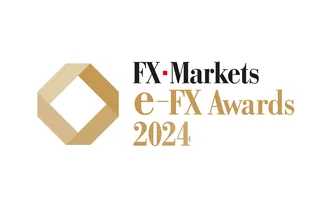
AWARDS Thomson Reuters comes top in two categories

A shelf of awards reminds Thomson Reuters’s co-head of trading, Neill Penney, of the firm’s legacy and capabilities in foreign exchange markets. This time, the company will collect three more trophies at the 2017 FX Week Best Bank Awards – Best Broker for Emerging Markets, Best Broker for Forward FX and Best Vendor for Dealing Technology.
“It’s an honour for us to win,” Penney says. “When I look at this year’s awards in particular, what was especially important to me is the validation of our market-leading solutions, both in emerging markets and established markets.”
On top of its suite of products, Thomson Reuters has an outstanding global customer reach. Its electronic trading solution commands the attention of 240 banks, which use it to provide prices electronically, and the firm can boast its trading technology is on more than 3,600 trading floors worldwide.
Those hundreds of relationships, according to Penney, enable Thomson Reuters to better understand market requirements and build new solutions to aid client business. What the firm has also come to recognise is that features are not the end-all.
“Operational excellence tends to get taken for granted and people tend to talk about features, but fundamentally, the way the market is going is operational excellence. The bar is continuously going up and we put a lot of energy internally into making sure our products are absolutely buttoned down,” Penney tells FX Week.
A great proof point of that was at the end of September, [when] we had a record day of $619bn. We were really proud that on such a busy day the systems performed absolutely flawlessly
Neill Penney, Thomson Reuters
“I think a great proof point of that was at the end of September, [when] we had a record day of $619 billion. We were really proud that on such a busy day the systems performed absolutely flawlessly. Of course, on a busy day our clients relied on us to be there when they needed to trade,” he adds.
The second Markets in Financial Instruments Directive, set to take effect on January 3, has been the biggest challenge for Thomson Reuters and its customers this year. The firm became a multilateral trading facility and in order to accommodate its clients outside Europe, it created a new legal entity in Singapore.
“Mifid is enormously complicated. I think it is one of those challenges that as we get closer to the finish line across the industry, people are understanding how much work there is to do,” Penney says. “As our customers are working through the challenges of Mifid, we wanted to – and needed to – engage with them and listen to their interpretations of Mifid.”
“I think, in terms of where we are going to be, we will come out in very good shape at the end of this year as Mifid becomes law. Then I think there will be another quarter of really tidying up,” he adds.
New partnerships
Thomson Reuters has been quite active over the last couple of years in terms of forming new partnerships to strengthen its product offerings and providing customers with a one-stop shop for their FX needs.
In December 2016, the firm bought a minority stake in independent transaction cost analysis provider BestX. Months later, Thomson Reuters launched an improved version of its data analytics platform, Velocity Analytics, powered by Kx technology, to support the upcoming launch of new multi-asset best execution and systematic internaliser-determination capabilities in 2018.
“We have done a lot of set-up work over the last few years and I think all the pieces will now come together for our customers at the end of this year,” Penney says. “The FX trading migration we did was a huge piece of work that took several years, but all of our customers now have a next-generation trading system in front of them, with access to technology such as FXall, which they didn’t have before.”
Operational excellence
Come next year, Thomson Reuters’s money is still behind operational excellence and safety.
“It is the hidden item, and I think increasingly it is so important for our customers to know that however busy the day, the system is up and bullet-proof. It just takes a lot of work behind the scenes to make sure that’s the case and to roll out complex new functionalities such as Mifid,” Penney says.
“We have a programme that we’ve had for several years now, of constantly tightening up our standards, and our safety and robustness. We are all very proud internally of the progress we have made. We know it is important to our customers,” he adds.
Only users who have a paid subscription or are part of a corporate subscription are able to print or copy content.
To access these options, along with all other subscription benefits, please contact customer services - www.fx-markets.com/static/contact-us, or view our subscription options here: https://subscriptions.fx-markets.com/subscribe
You are currently unable to print this content. Please contact customer services - www.fx-markets.com/static/contact-us to find out more.
You are currently unable to copy this content. Please contact info@fx-markets.com to find out more.
Copyright Infopro Digital Limited. All rights reserved.
As outlined in our terms and conditions, https://www.infopro-digital.com/terms-and-conditions/subscriptions/ (point 2.4), printing is limited to a single copy.
If you would like to purchase additional rights please email info@fx-markets.com
Copyright Infopro Digital Limited. All rights reserved.
You may share this content using our article tools. As outlined in our terms and conditions, https://www.infopro-digital.com/terms-and-conditions/subscriptions/ (clause 2.4), an Authorised User may only make one copy of the materials for their own personal use. You must also comply with the restrictions in clause 2.5.
If you would like to purchase additional rights please email info@fx-markets.com
More on Awards
J.P. Morgan brings greater transparency to the overlay space
Demand for J.P. Morgan’s FX overlay market services has risen significantly as market participants navigate the hedging and execution complexities of the market
Best prime-of-prime broker: Saxo
With its well-rounded offering and solid balance sheet, Saxo stood out as a trusted liquidity partner, regardless of market conditions
OSTTRA tackles FX risk with new settlement orchestration and expanded optimisation tools
OSTTRA has added settlement orchestration to its suite of FX services to help clients optimise their derivatives portfolios and tackle critical challenges in the market
Best trading technology for FX: smartTrade Technologies
As sell-side market participants more readily accept the integration of machine learning and AI into their processes, smartTrade Technologies unveils advanced services and modules that provide clients with powerful tools to maximise trading efficiency
Best liquidity aggregation service: smartTrade Technologies
With more sophisticated workflows at their fingertips, second-tier market participants are capitalising on smartTrade Technologies’ bespoke services and modules to gain a competitive edge
e-FX awards 2024: The winners
JP Morgan takes home a record five wins, while BNP, DB and NatWest have two each
CME Group bags top awards for FX derivatives and spot
Amid bouts of Apac volatility, market participants tap into CME Group’s deep pools of FX liquidity, seeking certainty in times of economic stress
Best trading platform for retail: OCBC Bank
OCBC diversifies its FX offering with more currencies and 24/7 trading to meet the increasingly sophisticated needs of retail and SME clients








